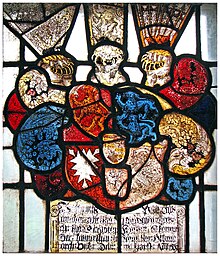| This article includes a list of references, related reading, or external links, but its sources remain unclear because it lacks inline citations. Please help improve this article by introducing more precise citations. (November 2018) (Learn how and when to remove this message) |
You can help expand this article with text translated from the corresponding article in Norwegian. (June 2012) Click for important translation instructions.
|
Duke of Schleswig-Holstein-Haderslev
| John the Elder | |
|---|---|
 | |
| Duke of Schleswig-Holstein-Haderslev | |
| Reign | 1544–1580 |
| Born | (1521-06-21)21 June 1521 Haderslevhus Castle, Haderslev, Denmark |
| Died | 1 October 1580(1580-10-01) (aged 59) Hansborg Castle, Haderslev, Denmark |
| Burial | February 1581 Schleswig Cathedral |
| House | Oldenburg |
| Father | King Frederick I of Denmark |
| Mother | Sophie of Pomerania |
| Religion | Lutheranism |
| Danish Royalty |
| House of Oldenburg Main Line |
|---|
 |
| Frederick I |
John of Denmark or John the Elder (aka Hans the Elder) (German: Johann der Ältere or Hans der Ältere; Danish: Hans den Ældre;) (29 June 1521 - 1 October 1580; born and died in Haderslev) was the only Duke of Schleswig-Holstein-Haderslev. The predicate the Elder is sometimes used to distinguish him from his nephew, John the Younger, who held Sønderborg from 1564 as a partitioned-off duke. As a co-ruler in the duchies of Holstein and of Schleswig, John the Elder is numbered as John II, continuing counting King John of Denmark as John I, Duke of Holstein and Schleswig.
Family

John was the son of King Frederick I of Denmark and his second wife, Sophie of Pomerania. As a possible heir to the throne, he enjoyed a careful education and spent several years at the court of his brother-in-law Albert, Duke of Prussia, in Königsberg. This was in Lutheran Ducal Prussia, a Polish fief, modernized into a secular state from the Teutonic State of Prussia since 1525. This successful policy would be seminal for John's understanding of politics and the state, as he also never became a fully sovereign prince.
Reign as Duke (1544–1580)
From 1544, John ruled the duchies of Schleswig and of Holstein jointly with his brother, Adolf of Denmark, and his half-brother, King Christian III of Denmark. He ruled from Haderslevhus Castle and later built Hansborg Castle in his hometown, a magnificent Renaissance palace situated east of the city of Haderslev.
His territory consisted of the Counties of Haderslev, including Tørning, Tønder, and Løgumkloster, and the islands of Nordstrand and Fehmarn in Schleswig, plus Rendsburg and some smaller communities in Holstein.
During his reign, John joined the Reformation and founded several social and educational institutions, notably the Duke John Hospital in Haderslev. He introduced many reforms to the legal system and was regarded as a dedicated judge. As one of the first rulers between the seas, he sat down for an active land reclamation and coastal protection program, presumably, he ruled over the most vulnerable stretch of the Schleswig coastline. In 1559, John, his brother Adolf, and King Christian's successor, Frederick II of Denmark, occupied the independent peasant Republic of Dithmarschen, and divided it among themselves.
John died unmarried and childless in 1580. After his death, his territory was divided between his brother Adolf and his nephew Frederick II of Denmark.
Legacy
In contrast to most of the dukes of Schleswig and Holstein, posterity has a very positive view of John the Elder. This holds especially for his capital Haderslev, which was a ducal residence only during his time and has benefited ever since. he is still popular as a sort of patron saint. The largest annual summer festival in Haderslev, the Hertug-Hans-Fest is named after, and the local brewery Fuglsang has named a beer after him (Hertug Hans Pils). Even the hospital (which he founded) still bears his name. His judgments were fully published in book form (De Hansborgske Dømme).
Ancestry
| Ancestors of John II, Duke of Schleswig-Holstein-Haderslev | ||||||||||||||||||||||||||||||||||||||||||||||||||||||||||||||||||||||||||||||||||||||||||||||||||||||||||||||||||||||||||||||||||||||||||||||||||||||||||||||||||||||||||||||||||||||||||||||||||||||||||||||||||||||||||||||||||||||||||||||||||||||||||||||||||||||||||||||||||||||||||||||||||||||||||||||||||||||||||||||||||||||||||||||||||||||||||||||||||||||||||||||||||||||||||||||||||||||||||||||||||||||||||||||||||||||||||||||||||||||||||||||||||||||||||||||||||||||||||||||||||||||||||||||||||||||||||||||||||||||||||||||||||||||||||||||||||||||||||||||||||||||||||||||||||||||||||||||||
|---|---|---|---|---|---|---|---|---|---|---|---|---|---|---|---|---|---|---|---|---|---|---|---|---|---|---|---|---|---|---|---|---|---|---|---|---|---|---|---|---|---|---|---|---|---|---|---|---|---|---|---|---|---|---|---|---|---|---|---|---|---|---|---|---|---|---|---|---|---|---|---|---|---|---|---|---|---|---|---|---|---|---|---|---|---|---|---|---|---|---|---|---|---|---|---|---|---|---|---|---|---|---|---|---|---|---|---|---|---|---|---|---|---|---|---|---|---|---|---|---|---|---|---|---|---|---|---|---|---|---|---|---|---|---|---|---|---|---|---|---|---|---|---|---|---|---|---|---|---|---|---|---|---|---|---|---|---|---|---|---|---|---|---|---|---|---|---|---|---|---|---|---|---|---|---|---|---|---|---|---|---|---|---|---|---|---|---|---|---|---|---|---|---|---|---|---|---|---|---|---|---|---|---|---|---|---|---|---|---|---|---|---|---|---|---|---|---|---|---|---|---|---|---|---|---|---|---|---|---|---|---|---|---|---|---|---|---|---|---|---|---|---|---|---|---|---|---|---|---|---|---|---|---|---|---|---|---|---|---|---|---|---|---|---|---|---|---|---|---|---|---|---|---|---|---|---|---|---|---|---|---|---|---|---|---|---|---|---|---|---|---|---|---|---|---|---|---|---|---|---|---|---|---|---|---|---|---|---|---|---|---|---|---|---|---|---|---|---|---|---|---|---|---|---|---|---|---|---|---|---|---|---|---|---|---|---|---|---|---|---|---|---|---|---|---|---|---|---|---|---|---|---|---|---|---|---|---|---|---|---|---|---|---|---|---|---|---|---|---|---|---|---|---|---|---|---|---|---|---|---|---|---|---|---|---|---|---|---|---|---|---|---|---|---|---|---|---|---|---|---|---|---|---|---|---|---|---|---|---|---|---|---|---|---|---|---|---|---|---|---|---|---|---|---|---|---|---|---|---|---|---|---|---|---|---|---|---|---|---|---|---|---|---|---|---|---|---|---|---|---|---|---|---|---|---|---|---|---|---|---|---|---|---|---|---|---|---|---|---|---|---|---|---|---|---|---|---|---|---|---|---|---|---|---|---|---|---|---|---|---|---|---|---|---|---|---|---|---|---|---|---|---|---|---|---|---|---|---|---|---|---|---|---|---|---|---|---|---|---|---|---|---|---|---|---|---|---|---|---|---|---|---|---|---|---|---|---|---|---|---|---|---|---|---|---|---|---|---|---|---|---|---|---|---|---|---|---|---|---|---|---|---|---|---|---|---|---|---|---|---|---|---|---|---|---|---|---|---|---|---|---|---|---|---|---|---|---|---|---|---|---|---|
| ||||||||||||||||||||||||||||||||||||||||||||||||||||||||||||||||||||||||||||||||||||||||||||||||||||||||||||||||||||||||||||||||||||||||||||||||||||||||||||||||||||||||||||||||||||||||||||||||||||||||||||||||||||||||||||||||||||||||||||||||||||||||||||||||||||||||||||||||||||||||||||||||||||||||||||||||||||||||||||||||||||||||||||||||||||||||||||||||||||||||||||||||||||||||||||||||||||||||||||||||||||||||||||||||||||||||||||||||||||||||||||||||||||||||||||||||||||||||||||||||||||||||||||||||||||||||||||||||||||||||||||||||||||||||||||||||||||||||||||||||||||||||||||||||||||||||||||||||
Sources
- Thomas Otto Achelis: Haderslev i gamle Dage 1292–1626, Haderslev, 1929
- Troels Fink: Hertug Hans den Ældre, in: Sønderjyske Årbøger, 1997, p. 37–58
- Lennart S. Madsen: Junker Christian og hertug Hans den Ældre, in: Inge Adriansen, Lennart S. Madsen and Carsten Porskrog Rasmussen: De slesvigske hertuger, Aabenraa, 2005, p. 87–118
- Emilie Andersen (ed.): De Hansborgske Registranter, two volumes, Copenhagen 1943 and 1949
- Emilie Andersen (ed.): De Hansborgske Domme 1545–1578, three volumes, Copenhagen, 1994
| John of Schleswig-Holstein-HaderslevHouse of Schleswig-Holstein-HaderslevCadet branch of the House of OldenburgBorn: 29 June 1521 in Haderslev Died: 1 October 1580 in Haderslev | ||
| Regnal titles | ||
|---|---|---|
| New title sharing rule and revenues in Holstein and Schleswig among the brothers |
— TITULAR — Duke of Schleswig-Holstein-Haderslev 1544–1580 |
no issue his brother and nephew inherited |
| Preceded byChristian III | Duke of Holstein and Duke of Schleswig as John II 1544–1580 with Adolf (1544–1586) Christian III (1523–1559) Frederick II (1559–1588) |
Succeeded byAdolf and Frederick II (in condominial rule) |